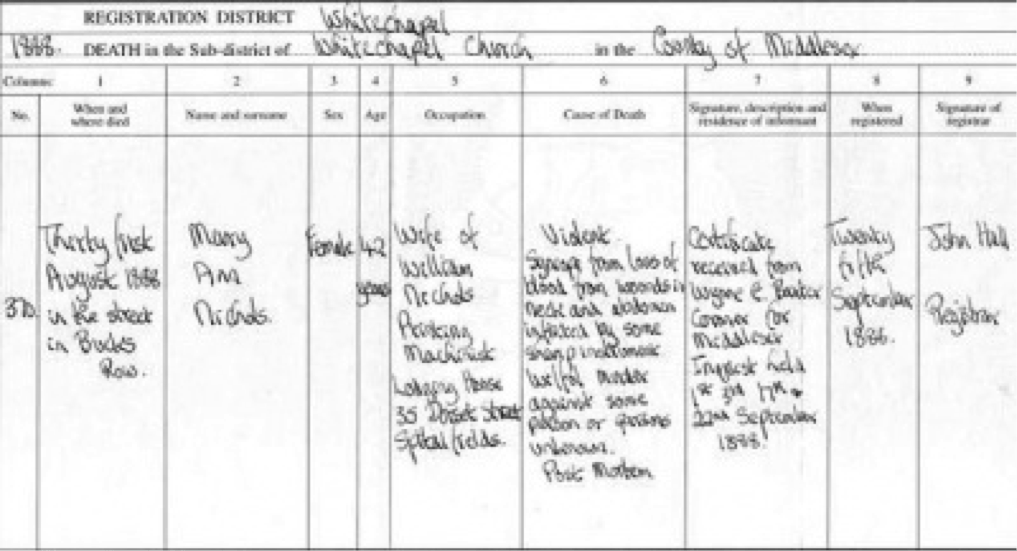Born on August 26, 1845 in London England, Mary Ann Walker was raised by locksmith Edward Walker and his wife Caroline. She married William Nichols, a printer’s machinist, in 1864; however, the couple divorced due to Mary’s drinking habits and prostitution allegations. Mary, now Mary Anne Nichols, continued practicing prostitution and was known for moving between workhouses and boarding houses, and living off charitable donations.

Prostitutes in Europe were regarded with mixed feelings in the nineteenth century. An awareness for the vulnerability of women prostitutes was fairly low and they were treated with curiosity as well as disgust. They had few economic options for making their way in the world and the women themselves were generally born into poverty and had little education or work skills. London prostitutes, especially those who operated on the streets, regularly picked the pockets of the men they preyed on. They kept an eye out for drunkards, from whom they could steal without the risk of being caught. However, this wasn’t the case with Mary as she herself spent most of her waking hours under the influence. Prostitution was very much frowned upon in London, and the women engaging in the profession were seen as the lowest of the low. It wasn’t unusual for men to beat and kill a prostitute after a ‘session,’ so when Mary Ann was found dead with her skirt lifted above her stomach, it was nothing out of the ordinary.1
The night in question was August 30, 1888. A heavy rain was falling on London during one of the coldest and wettest summers on record. Mary Ann was last seen walking down Whitechapel Road, and more than likely she was there soliciting her trade. Prostitution was a very dangerous profession one hundred thirty years ago. With no proper policing and the women themselves looked upon as animals, people would do with them as they pleased. No wonder the infamous ‘Jack the Ripper’s’ victims were all prostitutes.2 They were easy targets, and he was able to get away with murder.
Nichols was often found in the lodging house on 18 Thrawl Street; however, on this specific night she was knocked back due to a lack of money.3 Mary wasn’t fazed by this though, and was on her way back to her ‘office,’ the streets. At 2:30 am she ran into Emily Holland, another worker, who described Mary to be drunk and staggered against a wall. She told Emily that she was off to find another ‘punter’ in an attempt to get her ‘doss’ money in order to rest her head that night.4 One can’t help but think that Mary was selected by Jack because of her drunkenness and through no fault of her own she was destined to a brutal ending because she was such an easy victim. Emily Holland was the last known person to interact with Mary, and only one hour later, at 3:40 am, the latter was found cold and lifeless on the side of Bucks Row, a mere ten minutes walk from where the interaction took place.5

Constable Thain and Sergeant Kerby both passed down Bucks Row at 3:15, but reported nothing out of the ordinary. One must wonder what Nichols was doing from 2:30 to 3:40. She was only ten minutes away from Bucks Row, yet was found dead there seventy minutes later. Another thought would be: what was Jack the Ripper doing during that time. 6
Nichols’ body was initially found by two workmen, who both decided to leave her lying, as they didn’t want to be late for work. However, they let a police officer know her whereabouts on their way. Major bruising was found on Mary’s body and five of her teeth were missing. Investigators put this down to the struggle. Nevertheless, there were several deep cuts along her abdomen, which shows that her attacker enjoyed closeness with his victim, whom he supposedly raped and then mutilated. One can only speculate on why these cuts were made as they were, in no pattern, and didn’t relate to anything. As the first kill, maybe Jack was experimenting with Mary, and she was some sort of sick puppet in which his fantasies could be played out.7

Mary was buried on Thursday, September 6 of that year in the City of London’s Cemetery.8 Two days later, another of Jack’s victims, Annie Chapman, was found in the back garden of a London flat.9 Her womb had been removed and her body left horrifically mutilated. Jack the Ripper had indeed struck a second time. He wasted no time in preparing his second victim, yet this time it was more brutal than the first. One may wonder if Jack had attempted to remove Mary’s womb, but was perhaps disturbed and fled the scene before he could complete the operation.10 Jack the Ripper’s third victim was Elizabeth Stride. She was found at 1:00 am in Dutfield’s Yard, London. The fact that her throat had been cut, but the rest of her body had not been touched, led to speculation that her killer had been interrupted. This links with Mary Ann’s case because it is believed that Jack was also interrupted while working on her. One may believe that Jack liked the excitement of being caught, as he seemed to carry out his kills in the middle of streets. The fourth victim was found in Mitre Square in the City of London at 1:45 am. Catherine Eddowes was savagely mutilated by The Ripper, as her face was torn off and her uterus was missing along with her kidney. Clearly, Jack had not been interrupted this time. On November 9, the body of Mary Kelly was found in her room in Miller’s Court at 10:45 am. She had been virtually skinned to the bone and many experts believed that she was Jack the Ripper’s final victim. This was a fitting finale for the sick monster, as he chose a private area in order to carry out his most disturbing kill of all.11
For well over one hundred years since the time of the murder of Mary Ann and the rest of Jack’s victims, the identity of the killer has been regularly questioned, with nearly one hundred suspects having been named in the process. While many theories exist, none of them have proven to be indisputably convincing. Many think the Ripper was a commoner, possibly a butcher or other tradesman, who lived locally and was employed during the week, explaining why the murders occurred on or near the weekend. A lot of experts also agree that the Ripper was a local to Whitechapel. One of the most compelling suspects was Thomas Hayne Cutbush, who was a violent youth diagnosed insane at the time of the murders in 1888, and was believed to be wandering the streets of London throughout the time of the killings. Subsequently, the murders then stopped after Cutbush was locked up. Disappointingly, this information, along with more evidence, did not prove that Cutbush and Jack the Ripper were the same man; but there was enough evidence to keep Cutbush on the suspect list.12
The finger of suspicion was first pointed at Cutbush in 1894, by The Sun newspaper.13 The article claimed that despite the popular theory of the Ripper being dead, he was in fact a mental patient. The Sun’s detailed description clearly resembled that of Cutbush. The suspicion was that the Metropolitan Police covered up his guilt to avoid the embarrassing outcry that would have followed if the country’s most feared serial killer was found to be Superintendent Henry Cutbush’s nephew. Henry was a high ranked officer, whose reputation could have been seriously damaged if his relative was found to be Jack the Ripper. This is another reason why Thomas Cutbush was actively considered as a suspect.
Some named Cutbush as the No 1 Ripper suspect, but others have strongly denied this theory. Its main weakness is that the last known Ripper victim died in November 1888, at the end of the eleven week killing spree. If Cutbush was the killer, it seems odd that he would commit five murders over such short a period of time, stop for more than two years, and then commit one more assault, in which his victim survived. But there is almost no chance that the case will ever be solved. Thomas Hayne Cutbush remains top of the suspect list.14
It’s an eerie thought that this case will never be solved and even if it is, there is no one to suffer the consequences. It’s even scarier to think that there may currently still be serial killers on the run now that will also never be found and charged for their crimes. There will never be any justice for Jack the Rippers victims, but they can be certain they will never be forgotten.
- Mary Spongberg, The Body of the Female Prostitute in the Nineteenth-Century (New York, NY: New York University Press, 1997), 83-85. ↵
- Encyclopaedia Britannica, July 1998, s.v, “Jack the Ripper, English Murderer,” by John Phillip Jenkins. ↵
- Knocked back means dismissed. ↵
- A punter is a client. Doss is rent. ↵
- Stephen P. Ryder, “Casebook Jack the Ripper,” Victims: Last Addresses, August 14, 2009, 2, www.casebook.org/victims/polly.html. ↵
- Stephen P. Ryder, “Casebook Jack the Ripper.” Victims: Last Addresses, August 14, 2009, 2, www.casebook.org/victims/polly.html. ↵
- Salem Press Encyclopedia, January 2016, s.v. “Jack the Ripper,” by Cait Caffrey. ↵
- Death Certificate: no.370. 25 September, 1888. http://www.casebook.org/victims/polly.html ↵
- A back garden is a backyard. ↵
- William D. Rubenstien, “The Hunt For Jack the Ripper,” Ripper Diaries, (May 2000): 1-3. ↵
- Richard Jones, “Jack The Ripper 1888,” Victims (13 March 2016): 3. ↵
- Andy McSmith, “Madman’s notes throw new light on Ripper case,” The Independent article London, (19 November 2008). ↵
- A tabloid newspaper published in the United Kingdom and Ireland. ↵
- Richard Wheatsone, “Ripping Discovery,” The Sun (16 September 2017). ↵



211 comments
Gabriela Serrato
Jack the Ripper is probably one of the most notorious killers of all time, and he is definitely heard of by many. I have heard of him, but I must also admit that there was so much about the story that I did not know. I was not aware of how brutal and gruesome the murders were. Reading the descriptions was almost too much for me to handle. It is such a tragedy that women were targeted because they were “easy” ones. Actually, it infuriates me. It is a harsh world for women to live in when there are deranged men like this who see women as objects and not people.
Josselyn Arrieta-Meraz
This was such an interesting and heartbreaking article to read. But what kept me reading was the mystery behind it all. I personally was not familiar with Jack the Ripper. What he did to all the women is horrifying to read, the fact that many of these women most likely had no other way of income, and were left with no option but to be prostitutes really makes you think of the circumstances these women were in, they knew they were in constant danger, but to be treated and taken advantage by man in such way, really allows you to see the evilness this man carried. How mentally ill he must have been to think that this was right. And the fact that nothing was done, there was no punishment or investigation at the time is really sad.
Dayna Valdez
It was a very well written article. I was able to get a better understanding of how prostitution and prostitutes were viewed and learn a little bit about how things worked during that time. Crazy to think that many knew there was a possibility of getting killed. It is even crazier to know that these crimes have still yet to be solved and may never be.
Tara Sellers
I have heard about Jack the Ripper but I did not know the whole story. It is sad that it was normal to find prostitutes dead. They are humans not matter what their profession was. It is unsettling that they never found the person who did such horrific things. The article is good in explaining not only the events of what happened but also what may have been the cause of certain things. Like how Jack the Ripper may have been interrupted. Also, I wonder why we call him Jack the Ripper. In the article it just says people started calling him the Ripper. Where did the jack come from?
Ernie Sano
Concepts that involve death and mystery always make for an entertaining story. This article finds a way to tell of a rather dark and eerie subject in a manner that captivates the reader and keeps them wanting more. This is extremely admirable especially in an article that really has no answer. Jack the Ripper is a case that will haunt the dreams of individuals for centuries to come.
Blanca Martinez
Jack the Ripper has always been an interesting topic to me. It was always interesting to see all the conspiracies people would come up with to conclude who really was Jack the Ripper and why he did what he did. I actually believed he killed many more women than 5 or 4. It is actually all very weird, makes anyone question why anyone would be sadistic enough to do something like this and what exactly drove them to the point.
Manuel Aguilera
I had never stopped to consider who Jack’s first victim, nonetheless was a fully aware of what he had done in the first place. I was unaware that he was never caught nor did I know that he aimed mainly for prostitutes. It is interesting to see that because of these insane killings that the discipline of forensics had developed into a very advanced unit in many countries today.
Valeria Hernandez
Benjamin Voy wrote a chilling article about the infamous killers of London Jack the Ripper. Voy uses fantastic description for the crimes of Jack the Ripper. He is able to captivate the reader’s attention by telling the scary story of Jack the Ripper’s first victim. This article is particularly interesting because it informs the readers of multiple concepts. For example, possible theories, suspects, and victims.
Sebastian Castro Ramos
I knew little about Jack the Ripper prior to reading your article, and it is terrifying how this man dared to do the terrible things described on the article in plain sight. This man must have really been mentally ill to murder and mutilate women the way he did. I imagine prostitutes in London during that time might have been reluctant to go out to work in fear of encountering Jack the Ripper. Excellent article, it was very well developed and very engaging.
Thomas Fraire
This article was wild, I had never heard of Jack the Ripper before reading this. It’s crazy how he targeted Prostitutes specifically and how it was just a chain of people that he killed. This story was told very well and it kept me captivated the whole time. From the very beginning it was a very well written article, I enjoyed it.